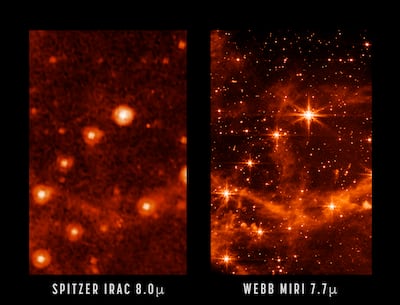Nasa will release the "deepest image of the universe" on July 12, the first of the scientific photographs taken by the space agency’s $10 billion James Webb Space Telescope.
The in-depth, full-colour pictures will depict places much further away taken those by the Hubble Space Telescope of galaxies formed a few hundred million years after the birth of the universe.
The Hubble was launched into low Earth orbit in 1990 and remains in operation.
Nasa officials held a virtual media briefing on Wednesday, to offer an idea of what the pictures taken by the world’s most powerful space telescope would reveal.
Some photos have already been taken by James Webb to test the telescope, but now the science operations have started.
“We are going to give humanity a new view of the cosmos, it’s a view we have never seen before,” said Bill Nelson, Nasa’s administrator.
“One of those images is the deepest image of our universe that has ever been taken.
“This is further than humanity has ever looked before and we’re only beginning to understand what Webb can and will do.
“It will explore objects in the solar system, atmospheres of exoplanets orbiting other stars, giving us clues if their atmospheres are similar to our own.”
Scientific images are produced within a specific discipline for research purposes and those to be presented on July 12 are likely to include a spectrum of planets outside of our solar system.
This could help astronomers to find out how the planet was formed.
“It may answer some questions that we have, where do we come from, what more is out there, who are we and of course it’ll answer some questions that we don’t even know what the questions are,” said Mr Nelson.
“In many ways, Webb’s journey has just begun.”
It was also revealed that the telescope, which took more than 20 years to build and was launched in December, has enough fuel for 20 years of operation.
Pamela Melroy, deputy administrator of Nasa, said it will be the focus of the space agency’s astrophysics mission.
“Not only will those 20 years allow us to go deeper into history and time, but we’ll go deeper in science because we have the time to learn and grow and make new observations,” she said.
Described as a time-travel machine, the space observatory is 100 times more powerful than the Hubble, which for 31 years has made countless discoveries and provided millions of images of planets, galaxies, nebulas and stars.
It is orbiting the Sun, in a place called the Lagrange Point — a position in space that allows the telescope to reach deeper into the universe.
The observatory’s cameras are so sensitive they can spot the heat signature of a bumblebee on the Moon's surface.
James Webb Telescope launch - in pictures
UPI facts
More than 2.2 million Indian tourists arrived in UAE in 2023
More than 3.5 million Indians reside in UAE
Indian tourists can make purchases in UAE using rupee accounts in India through QR-code-based UPI real-time payment systems
Indian residents in UAE can use their non-resident NRO and NRE accounts held in Indian banks linked to a UAE mobile number for UPI transactions
The five pillars of Islam
The years Ramadan fell in May
More from Rashmee Roshan Lall
Scores
Wales 74-24 Tonga
England 35-15 Japan
Italy 7-26 Australia
White hydrogen: Naturally occurring hydrogen
Chromite: Hard, metallic mineral containing iron oxide and chromium oxide
Ultramafic rocks: Dark-coloured rocks rich in magnesium or iron with very low silica content
Ophiolite: A section of the earth’s crust, which is oceanic in nature that has since been uplifted and exposed on land
Olivine: A commonly occurring magnesium iron silicate mineral that derives its name for its olive-green yellow-green colour
Disclaimer
Director: Alfonso Cuaron
Stars: Cate Blanchett, Kevin Kline, Lesley Manville
Rating: 4/5
UAE currency: the story behind the money in your pockets
Israel Palestine on Swedish TV 1958-1989
Director: Goran Hugo Olsson
Rating: 5/5
SPEC%20SHEET%3A%20NOTHING%20PHONE%20(2)
%3Cp%3E%3Cstrong%3EDisplay%3A%3C%2Fstrong%3E%206.7%E2%80%9D%20LPTO%20Amoled%2C%202412%20x%201080%2C%20394ppi%2C%20HDR10%2B%2C%20Corning%20Gorilla%20Glass%3C%2Fp%3E%0A%3Cp%3E%3Cstrong%3EProcessor%3A%3C%2Fstrong%3E%20Qualcomm%20Snapdragon%208%2B%20Gen%202%2C%20octa-core%3B%20Adreno%20730%20GPU%3C%2Fp%3E%0A%3Cp%3E%3Cstrong%3EMemory%3A%3C%2Fstrong%3E%208%2F12GB%3C%2Fp%3E%0A%3Cp%3E%3Cstrong%3ECapacity%3A%3C%2Fstrong%3E%20128%2F256%2F512GB%3C%2Fp%3E%0A%3Cp%3E%3Cstrong%3EPlatform%3A%3C%2Fstrong%3E%20Android%2013%2C%20Nothing%20OS%202%3C%2Fp%3E%0A%3Cp%3E%3Cstrong%3EMain%20camera%3A%3C%2Fstrong%3E%20Dual%2050MP%20wide%2C%20f%2F1.9%20%2B%2050MP%20ultrawide%2C%20f%2F2.2%3B%20OIS%2C%20auto-focus%3C%2Fp%3E%0A%3Cp%3E%3Cstrong%3EMain%20camera%20video%3A%3C%2Fstrong%3E%204K%20%40%2030%2F60fps%2C%201080p%20%40%2030%2F60fps%3B%20live%20HDR%2C%20OIS%3C%2Fp%3E%0A%3Cp%3E%3Cstrong%3EFront%20camera%3A%3C%2Fstrong%3E%2032MP%20wide%2C%20f%2F2.5%2C%20HDR%3C%2Fp%3E%0A%3Cp%3E%3Cstrong%3EFront%20camera%20video%3A%3C%2Fstrong%3E%20Full-HD%20%40%2030fps%3C%2Fp%3E%0A%3Cp%3E%3Cstrong%3EBattery%3A%3C%2Fstrong%3E%204700mAh%3B%20full%20charge%20in%2055m%20w%2F%2045w%20charger%3B%20Qi%20wireless%2C%20dual%20charging%3C%2Fp%3E%0A%3Cp%3E%3Cstrong%3EConnectivity%3A%3C%2Fstrong%3E%20Wi-Fi%2C%20Bluetooth%205.3%2C%20NFC%20(Google%20Pay)%3C%2Fp%3E%0A%3Cp%3E%3Cstrong%3EBiometrics%3A%3C%2Fstrong%3E%20Fingerprint%2C%20face%20unlock%3C%2Fp%3E%0A%3Cp%3E%3Cstrong%3EI%2FO%3A%3C%2Fstrong%3E%20USB-C%3C%2Fp%3E%0A%3Cp%3E%3Cstrong%3EDurability%3A%3C%2Fstrong%3E%20IP54%2C%20limited%20protection%3C%2Fp%3E%0A%3Cp%3E%3Cstrong%3ECards%3A%3C%2Fstrong%3E%20Dual-nano%20SIM%3C%2Fp%3E%0A%3Cp%3E%3Cstrong%3EColours%3A%3C%2Fstrong%3E%20Dark%20grey%2C%20white%3C%2Fp%3E%0A%3Cp%3E%3Cstrong%3EIn%20the%20box%3A%3C%2Fstrong%3E%20Nothing%20Phone%20(2)%2C%20USB-C-to-USB-C%20cable%3C%2Fp%3E%0A%3Cp%3E%3Cstrong%3EPrice%20(UAE)%3A%3C%2Fstrong%3E%20Dh2%2C499%20(12GB%2F256GB)%20%2F%20Dh2%2C799%20(12GB%2F512GB)%3C%2Fp%3E%0A
GIANT REVIEW
Starring: Amir El-Masry, Pierce Brosnan
Director: Athale
Rating: 4/5
Director: Laxman Utekar
Cast: Vicky Kaushal, Akshaye Khanna, Diana Penty, Vineet Kumar Singh, Rashmika Mandanna
Rating: 1/5
Tu%20Jhoothi%20Main%20Makkaar%20
%3Cp%3E%3Cstrong%3EDirector%3A%20%3C%2Fstrong%3ELuv%20Ranjan%26nbsp%3B%3C%2Fp%3E%0A%3Cp%3E%3Cstrong%3EStars%3A%20%3C%2Fstrong%3ERanbir%20Kapoor%2C%20Shraddha%20Kapoor%2C%20Anubhav%20Singh%20Bassi%20and%20Dimple%20Kapadia%3C%2Fp%3E%0A%3Cp%3E%3Cstrong%3ERating%3A%3C%2Fstrong%3E%203%2F5%3C%2Fp%3E%0A
The specs
Engine: 2-litre or 3-litre 4Motion all-wheel-drive Power: 250Nm (2-litre); 340 (3-litre) Torque: 450Nm Transmission: 8-speed automatic Starting price: From Dh212,000 On sale: Now
The Perfect Couple
Starring: Nicole Kidman, Liev Schreiber, Jack Reynor
Creator: Jenna Lamia
Rating: 3/5
Company profile
Date started: December 24, 2018
Founders: Omer Gurel, chief executive and co-founder and Edebali Sener, co-founder and chief technology officer
Based: Dubai Media City
Number of employees: 42 (34 in Dubai and a tech team of eight in Ankara, Turkey)
Sector: ConsumerTech and FinTech
Cashflow: Almost $1 million a year
Funding: Series A funding of $2.5m with Series B plans for May 2020
Global state-owned investor ranking by size
|
1.
|
United States
|
|
2.
|
China
|
|
3.
|
UAE
|
|
4.
|
Japan
|
|
5
|
Norway
|
|
6.
|
Canada
|
|
7.
|
Singapore
|
|
8.
|
Australia
|
|
9.
|
Saudi Arabia
|
|
10.
|
South Korea
|
The specs: Macan Turbo
Engine: Dual synchronous electric motors
Power: 639hp
Torque: 1,130Nm
Transmission: Single-speed automatic
Touring range: 591km
Price: From Dh412,500
On sale: Deliveries start in October
Company: Instabug
Founded: 2013
Based: Egypt, Cairo
Sector: IT
Employees: 100
Stage: Series A
Investors: Flat6Labs, Accel, Y Combinator and angel investors
Women%E2%80%99s%20T20%20World%20Cup%20Qualifier
%3Cp%3E%3Cstrong%3EUAE%20results%3C%2Fstrong%3E%0D%3Cbr%3EIreland%20beat%20UAE%20by%20six%20wickets%0D%3Cbr%3EZimbabwe%20beat%20UAE%20by%20eight%20wickets%0D%3Cbr%3EUAE%20beat%20Netherlands%20by%2010%20wickets%0D%3C%2Fp%3E%0A%3Cp%3E%3Cstrong%3EFixtures%3C%2Fstrong%3E%0D%3Cbr%3EUAE%20v%20Vanuatu%2C%20Thursday%2C%203pm%2C%20Zayed%20Cricket%20Stadium%0D%3Cbr%3EIreland%20v%20Netherlands%2C%207.30pm%2C%20Zayed%20Cricket%20Stadium%0D%3C%2Fp%3E%0A%3Cp%3E%3Cstrong%3EGroup%20B%20table%3C%2Fstrong%3E%0D%3Cbr%3E1)%20Ireland%203%203%200%206%20%2B2.407%0D%3Cbr%3E2.%20Netherlands%203%202%201%204%20%2B1.117%0D%3Cbr%3E3)%20UAE%203%201%202%202%200.000%0D%3Cbr%3E4)%20Zimbabwe%204%201%203%202%20-0.844%0D%3Cbr%3E5)%20Vanuatu%203%201%202%202%20-2.180%3C%2Fp%3E%0A
Getting%20there%20
%3Cp%3E%3Ca%20href%3D%22https%3A%2F%2Fwww.thenationalnews.com%2Ftravel%2F2023%2F01%2F12%2Fwhat-does-it-take-to-be-cabin-crew-at-one-of-the-worlds-best-airlines-in-2023%2F%22%20target%3D%22_self%22%3EEtihad%20Airways%20%3C%2Fa%3Eflies%20daily%20to%20the%20Maldives%20from%20Abu%20Dhabi.%20The%20journey%20takes%20four%20hours%20and%20return%20fares%20start%20from%20Dh3%2C995.%20Opt%20for%20the%203am%20flight%20and%20you%E2%80%99ll%20land%20at%206am%2C%20giving%20you%20the%20entire%20day%20to%20adjust%20to%20island%20time.%20%C2%A0%3C%2Fp%3E%0A%3Cp%3ERound%20trip%20speedboat%20transfers%20to%20the%20resort%20are%20bookable%20via%20Anantara%20and%20cost%20%24265%20per%20person.%20%C2%A0%3C%2Fp%3E%0A












